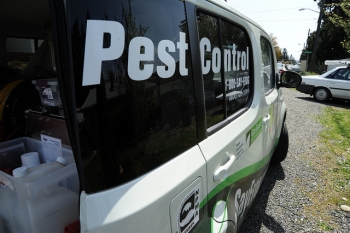Are Mites a Danger To You

Undoubtedly you have heard of mites, but you might not know just what these tiny creatures are. Mites are tiny arthropods that are related to ticks. And most people know that any friend of ticks is no friend of ours.
According to some estimates, there are nearly 43,000 different types of mites, and fortunately, not all are bothersome. Most, in fact, are harmless and prefer to feed on plant matter. Others, though, will invade homes and make quite a nuisance of themselves. So what type of pest control measures can you take against the tiny, but mighty mite?
Types of Mites
The good news is that few mites affect humans or become parasitic on people or animals. Of the tens of thousands of species, just a few turn to human sources for food. The tropical rat mite, tropical fowl mite, northern fowl mite (both fowl mites can affect wild and domestic birds) and the house mouse mite, for instance, can become biting pests.
How do they end up in your home? It could be a simple wrong turn. These outdoor pests “mite” find their way in accidentally. Other times, they are present on pet rats, mice, or birds. A reliable Brevard County Pest Control service can help you identify the mite and remove the source effectively.
The most common source of mite problems, though, is the dust mite or house mite. Because they feed on shed skin, they don’t actually bite. They do, however, cause and worsen respiratory issues, such as asthma and allergies. When they digest organic matter, like dead skin, they produce and excrete enzymes. They prefer to live in stable environments, especially those made of fabric – which makes your bed prime real estate. When you breathe in the enzymes from the feces, it can cause wheezing and other reactions, including:
- Excessive sneezing
- Itchiness
- Inflamed skin or eczema
- Watery eyes
- Congestion and runny nose
- Difficulty sleeping or staying asleep
Treating Dust Mites
A pest control specialist can help you tackle dust mites, and you can take some simple steps yourself:
- Treat your clothes/bedding in a dryer for at least 10 minutes.
- Invest in a down pillow. People with allergies are generally discouraged from buying down because of the myth that mites are attracted to the material. Not true; they are more likely to burrow into polyester fiber-fills.
- Buy an allergen-proof case for your mattress and for your pillows. A zippered case is an effective way to prevent infestation and dramatically reduce symptoms.
- Wipe down hard surfaces with a wet cloth; this simple step removes up to 90% of dust mites.
- Remove carpet, if possible. If not, vacuum it thoroughly and frequently. If you are very sensitive to mites, use a dust mask when cleaning.
Dust mites make nighttime miserable for asthma and allergy sufferers. Luckily, these steps and some assistance from a professional pest control company can help.
Article Source: http://www.slugabug.com/2014/01/28/mighty-mites-a-danger-to-you/
